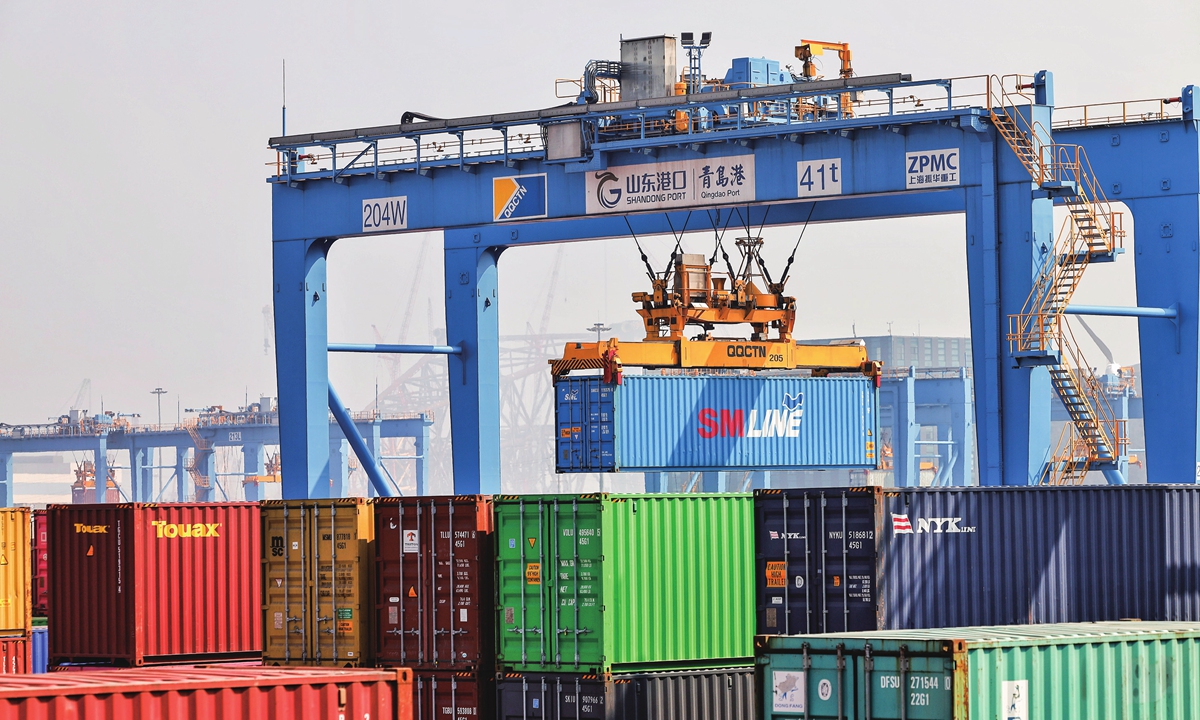Empty containers at Chinese ports reflect global market's optimism about nation's trade resilience: GAC head

A view of a fully automated container dock in Qingdao port, East China's Shandong Province on February 28, 2023. The operating efficiency of the smart port has been improved by 30 percent compared with traditional ports, with a world throughput record of 60.18 standard containers an hour. Photo: Li Hao/GT
The growing number of empty containers piling up at Chinese ports shows that the global market remains optimistic about the nation's export capacity, Yu Jianhua, head of the General Administration of Customs (GAC), said on Monday.
Yu said that the situation reflects excess containers that were released to the market, the low cost of storing containers at Chinese ports, and the quick turnaround of empty containers after the easing of the pandemic around the world.
Many empty containers are ready to move through Chinese ports, showing global confidence in China's export capability, according to Yu. Official data showed that the volume of containers has risen continuously since mid-February.
The previous global container shortage caused by the COVID-19 epidemic led to a surge in container production to support global industry and supply chains, insiders said, stressing that foreign carriers still focus heavily on Chinese ports amid the robust economic recovery.
A manager at a terminal in Qingdao port, East China's Shandong Province surnamed Huang told the Global Times that more foreign ships recently came to China for maintenance and then docked to await orders after unloading cargo, showing optimism about the prospects of China's foreign trade.
Even as containers piled up during the epidemic, partly due to labor shortage, more were being produced, leading to the current supply-demand imbalance, Wu Minghua, a veteran shipping analyst, told the Global Times on Monday.
Zhao Nan, a research fellow at the Shanghai International Shipping Research Center, noted that a post-pandemic consumption boom in some Western countries ebbed, affecting container demand.
In 2021, more than 7 million TEUs of containers were produced worldwide, nearly three times the usual level, China Media Group reported.
Storing containers in China is cheaper than in Europe or the US. Storing more containers at Chinese ports proves to be a reasonable way to ensure global supply chains as China remains the origin for various products. The containers can help the nation retain a timely balance between supply and market demand, Zhao told the Global Times on Monday.
Moreover, port authorities are striving to leverage the utilization efficiency of empty containers, such as switching more shipments to containers and using coordinating the use of containers for transferring goods domestically, Wu said.
The excess supply of containers shows that foreign enterprises are optimistic about China's trade recovery, and it doesn't mean China's foreign trade will decline, Gu Xueming, head of the Chinese Academy of International Trade and Economic Cooperation under the Ministry of Commerce, told China Media Group.
Yu said that the start of 2023 has seen a stable trade market, a signal of positive growth.
For instance, the combined exports of electric vehicles, lithium batteries and solar panel cells surged more than 60 percent, while cross-border e-commerce increased by 15.8 percent, according to Yu.
Despite external challenges and complex factors such as financial upheavals in some Western economies, China has retained its overall competitiveness in foreign trade, and China's economy is expected to regain impetus this year, which will aid trade, said Yu, adding that the GAC is confident in achieving the trade target for 2023.



